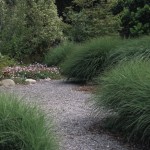The Dry Garden: Gravel is so much more than a way to cover up dirt
Posted on | July 15, 2009 | No Comments

David Fross's garden at Native Sons Nursery in Arroyo Grande, CA
WHEN the son of friends began using his mother’s cellphone to photograph the ground at a Sunday lunch in the garden, we grown-ups laughed. “Look at Leon.” But when Leon’s mother began looking at her son’s photographs, then showed them to me, Leon had the last laugh. There, frame after frame, were abstract compositions of mesmerizing beauty. Were Leon’s downward-looking portraits to have a title, it might have been: “Dappled Sunlight on Gravel and Fallen Leaves.”
Gravel is so much more than a way to cover up dirt. As Leon noticed, its ability to catch light makes the garden floor a dancing field of shadows. Gravel also transforms the way heat, coolness and water are retained. Then, as powerfully as anything, gravel brings music to the garden. There is nothing at once so pleasant and intriguing as the sound of footfall on gravel. For the plants grown in and around gravel, these seemingly aesthetic qualities are biological. In the right situation, gravel is an ideal habitat for dry gardening.
Click here to continue reading the Los Angeles Times Dry Garden column on gravel in the garden, and here for a photo gallery of gravel gardens.
*Katarina Eriksson, long time gardener at the Huntington in San Marino and now an independent garden designer, rang to say that she loved the gravel shopping element in the piece but that I’d forgotten to say how deep the 50′ x 50′ patch that I was so helpfully pricing for readers would go. It would go 2″. Thank you, Katarina!
**The photo gallery date has been changed from the 18th to the 20th.
Photos by Leon Ochoa Gold
Owen Dell, the voice of sustainable landscaping in Santa Barbara, and David Fross, co-founder of Native Sons Nursery in Arroyo Grande, made these comments about gardening with gravel after the LA Times deadline. The beauty of blogging is that they can be added as post-publication remarks rather than lost.
Fross was strongly influenced by Beth Chatto’s classic Gravel Garden. Plants that would never go to seed in mulched beds, such as Indian mallow and lavender, seed freely in gravel, he finds. He also enjoys the blank sheet quality of a gravel field and the freedom from rectilinear borders.
Dell also appreciates gravel as a luxury element in the garden, but sounded some cautions. The same quality that makes gravel such an excellent medium for growing wildflowers in Dell’s mind makes it a “weed magnet.” In my experience, this is less of an issue in Los Angeles, which gets considerably less rain than Santa Barbara, but it merits stressing that gravel put down for paths or non-planted areas should not be watered and will need weeding after winter rains.
Dell warns against running weed cloth beneath the gravel, which can make a tangled mess or require herbicides. He also believes that for many planting beds, it’s preferable to have organic mulch, which will help build the soil profile and absorbency. This organic soil profile, and not a rock face, will be crucial to capturing rain.
I would add the caution to use gravel where glare is not an issue because it will brighten the light, occasionally aggressively. It can also sharpen acoustics, so it’s best used where you want that … near a fountain or along a path for instance, but not in a dog run.
Finally, Dell warns that the dust from gravel can change the mineral profile of soil, and he urges care and restraint in using it around some established plants. -EG
This posting was updated 7/16/09
Comments
Leave a Reply






